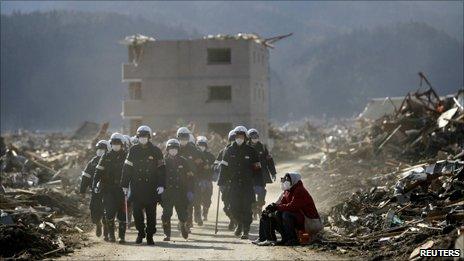Japan nuclear threat: The tsunami is the bigger tragedy
- Published

The apocalyptic visions of destruction brought by the Japanese earthquake and subsequent tsunami have been largely replaced in the media this week by reports of the struggle to control radiation from the stricken Fukushima nuclear plant.
This provides a gripping narrative - a brave team battling to contain the threat, warnings of catastrophe and claims of incompetence, families desperate to protect their children and leave the area.
But perhaps the media coverage tells us more about ourselves than it does about the threat of radiation.
Psychologists have spent years identifying the factors that lead to increased feelings of risk and vulnerability - and escaped radiation from nuclear plants ticks all the boxes.
It is an invisible hazard, mysterious and not understood, associated with dire consequences such as cancer and birth defects. It feels unnatural.
Perception and reality
In contrast, few in the west of England seem concerned at the natural radiation they are exposed to from the earth in the form of the gas radon, even though it is estimated to lead to more than 1,000 cancer deaths a year in this country.
But if radiation comes from an accident and has been imposed on us unwillingly, we feel we can't control it or avoid it.
It is therefore not surprising that the psychological effects of man-made and unintended radiation exposure, or even its possibility, are strong.
Many of the thousands of servicemen exposed to A-bomb tests suffered lifelong disability similar to post-traumatic stress disorder, and any effects of Three Mile Island were psychological, rather than caused by the minimal radiation exposure.
It has been estimated that 17 million were exposed to significant radiation after Chernobyl and nearly 2,000 people have since developed thyroid cancer having consumed contaminated food and milk as children.
This is very serious, but nothing like the impact that had been expected, and a UN report .
Risk communication in a crisis is vital
The perception of the extreme risk of radiation exposure is also somewhat contradicted by the experience of 87,000 survivors of Hiroshima and Nagasaki, who have been followed up for their whole lives.
By 1992, over 40,000 had died, but it has been estimated that only 690 of those deaths were due to the radiation. Again, the psychological effects were major.
Radiation does, however, feel acceptable when used in benign circumstances such as medical imaging. You can pay 拢800 ($1,280) and get a whole-body CT scan as part of a medical check-up, but it can deliver you .
Because more than 70 million CT scans are carried out each year, the US National Cancer Institute has estimated that 29,000 Americans will get cancer as a result of the CT scans they received in 2007 alone.
Barrage of opinions
Given extreme public concerns, risk communication in a crisis is vital.
The accepted wisdom is for governments to be open and honest, without denial or premature reassurance, to own up to risks and uncertainties, and to keep up a constant flow of consistent information while giving people clear instructions and something to do.
The Japanese authorities are struggling.
The electricity company appears to be as secretive as its reputation suggested and although the Japanese media are mostly giving the government an easy ride, individuals able to follow western sources are faced with a barrage of conflicting opinions.
The EU Energy Commissioner may have his own reasons for making extraordinary statements about apocalypse and imminent catastrophe.
The UK government's Chief Scientific Adviser Sir John Beddington, meanwhile, has had to revise his previously optimistic assessment to include the "worst case scenario" of radiation reaching Tokyo, albeit at a level which could be protected against.
Even under this worst case, though, the direct health consequences of the nuclear accident would be very small compared with the thousands already killed by the earthquake and tsunami, let alone the continued suffering of the survivors.
Maybe we should wait and see what happens before we decide what lessons to learn.
The Daily Mail science editor, Michael Hanlon, has already boldly claimed that "", given the success of most Japanese plants at withstanding a disaster they were never designed for, but others will use exactly the same information to reach the directly opposite conclusion.
Yesterday I asked an audience of 800 sixth-formers their opinion and, although they were pleased they weren't in Tokyo, the majority still thought nuclear was a sensible option for future energy.
Maybe the generation who know nothing of the Cold War are growing up with a different perspective on radiation?
David Spiegelhalter is Winton Professor of the Public Understanding of Risk at Cambridge University and a Senior Scientist in the Medical Research Council's Biostatistics Unit.
UPDATE: A has been released, which concludes that contaminated milk "led to a substantial fraction of the more than 6,000 thyroid cancers observed to date among people who were children or adolescents at the time of the accident (by 2005, 15 cases had proved fatal)". It adds: "To date, there has been no persuasive evidence of any other health effect in the general population that can be attributed to radiation exposure."